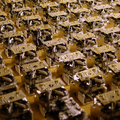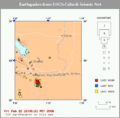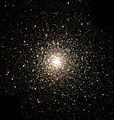Swarm facts for kids
A swarm is a very large group of animals, often moving together. While we usually think of insects like locusts when we hear "swarm," other animals like fish and birds can also form swarms. For example, a huge group of herring fish is called a school, but it's still a type of swarm. Mammals, like cows or deer, usually form groups called herds instead of swarms.
Swarm behaviour is when many animals of similar size gather together. They might stay in one spot or move as a big group, sometimes even migrating long distances. This amazing behaviour happens without any single leader telling everyone what to do.
Different animals have different names for their swarms:
- Birds often flock or form a murmuration.
- Land animals like sheep herd.
- Fish shoal or school.
Even tiny plant-like organisms called phytoplankton can gather in huge groups called "blooms." The idea of a "swarm" can even be used for non-living things that move together, like a robot swarm, an earthquake swarm, or even a swarm of stars!
How Swarms Work
Swarm behaviour is like a big, complex dance where each individual follows simple rules. Imagine a flock of birds: each bird just tries to stay close to its neighbours, match their speed, and avoid bumping into them. When every bird does this, the whole flock moves as one, even though no single bird is in charge. This is called an emergent behaviour – a complex pattern that appears from many simple actions.
Scientists study swarm behaviour to understand how these groups move without a leader. It's a bit like a puzzle, trying to figure out the simple rules that create such amazing patterns.
Early Computer Models of Swarms
One of the first times swarm behaviour was shown on a computer was in 1986 with a program called boids. This program used simple digital "agents" (like tiny virtual animals) called boids. Each boid followed just a few basic rules:
- Separation: Don't get too close to other boids.
- Alignment: Try to fly in the same direction as nearby boids.
- Cohesion: Try to stay near the center of the group of nearby boids.
When these simple rules were followed by many boids, they started to move just like a real flock of birds! This model helped scientists understand how complex group movements can come from very simple individual actions. It can be used to understand not just birds, but also schooling fish and other swarming animals.
Images for kids
-
A swarm of ants which have discovered a food source
-
A 19th century depiction of a swarm of desert locusts
-
Swarming krill
-
Sheep dogs (here a Border Collie) control the flocking behaviour of sheep
-
Swarms of jellyfish also prey on copepods
-
Salps arranged in chains form huge swarms.
-
A swarm of ladybirds
























